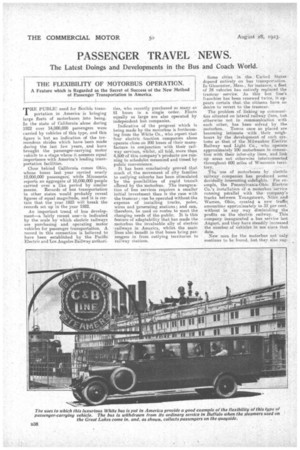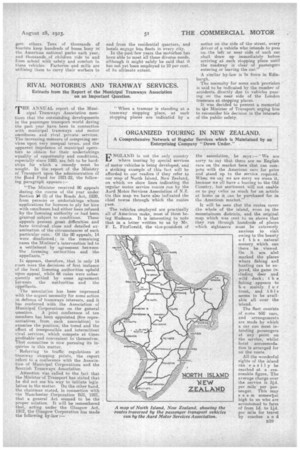PASSENGER TRAVEL NEWS.
Page 22

Page 23

If you've noticed an error in this article please click here to report it so we can fix it.
The Latest Doings and Developments in the Bus and Coach World.
THE FLEXIBILITY OF MOTORBUS OPERATION.
A Feature which is Regarded as the Secret of Success of the New Method of Passenger Transportation in America
rr HE PUBLIC need for flexible trans
portation in America is bringing large fleets of motorbuses into being. In the state of California alone during 1922 over 14,000000 passengers were carried by vehicles of this type, and this figure is but an indication of the tremendous strides which have been made during the last, few years, and have brought the passenger-carrying motor vehicle to a stage where it, assumes equal importance with America's leading transportation facilities.
Close behind California comes Ohio, whose buses last year carried nearly 12,000,000 passengers, while Minnesota reports an aggregate of 10,000,000 people carried over a like period by similar means. Records of bus transportation in other states would probably reveal figures of equal magnitude, and it is certain that the year 1923 will break the records set up in the year 1922.
An important trend of bus development—a fairly recent: one---is indicated by the scale by which electric railways are purchasing and operating motor vehicles for passenger transportation. A record in this connection is believed to have been established by the Pacific . Electric and Las Angeles Railway authori
ties, who recently purchased as many as B1 buses in a single order. Fleets equally as large are also operated by independent bus companies.
Indicative of the progress which is being made by the motorbus is forthcoming from the White Co., who report that four electric traction companies alone operate close on 200 buses of their manufacture in conjunction with their railway services, whilst, all told, more than 4,500 of this company's products are running to schedules measured and timed by public convenience.
It has been conclusively proved that much of, the movement of city families to outlying suburbs has been stimulated by the possibilities of rapid transit offered by the 'motorbus. The inauguration of bus services requires a smaller initial investment than is the case with the tramcar ; can be operated without the expense of installing tracks, poles, wires and generating stations ; and can, therefore, be used on routes to meet the changing needs of the public_ It is this feature of adaptability that has made the motorbus the invaluable ally of electric 'railways in America, whilst the main lines also benefit in that buses bring passengers in from outlying territories to railway stations. Some cities in the United States depend entirely on bus transportation. In Gloucester, Mass., for instance, a fleet of 24 vehicles has entirely replaced the tramcar service. As this bus line's franchise has been renewed twice, it appears certain that the citizens have no desire to revert to the tramcar.
The problem of linking up communities situated on lateral railway lines, hut otherwise not in communication with each other, has been solved by the Inotorbils. Towns once so placed are becoming intimate with , their neighbours by the development of such systems as that of the Milwaukee Electric Railway and Light Co., who operate approximately 100 motorbuses in connection with their inter-city lines, and link up areas not otherwise interconnected throughout 600 miles of Wisconsin territory.
The use of motorbuses by electric railway companies has produced some decidedly interesting sidelights. For example, the Pennsylvania-Ohio Electric Co.'s installation, of a motorbus service running pttrallel with the company's tracks between Youngstown, Niles and' Warren, Ohio, created a new traffic, amountincr apprctximately to 33 per bent, without in any way diminishing the, profits on the electric railway. This company inaugtrated a bus service last August, and they have steadily increased the number of vehicles in use since that date.
New uses for the motorbus not only continue to be found, but they also sug gest others. Tens of thousands of tourists keep hundreds of buses busy in the. American national parks each year, and thousands_ of children ride to and from school with safety and comfort in these vehicles. Factories and mills are utilizing them to carry their workers to and from the residential quarters, and hotels engage bus fleets in every city. In the past few yearS the motorbus has been able to meet all these diverse needs, although it might safely be said that it has not yet been employed to 10 per cent. of its ultimate extent.




























